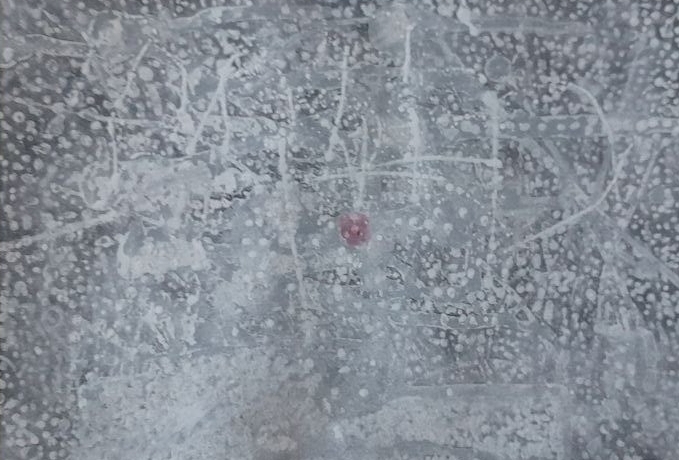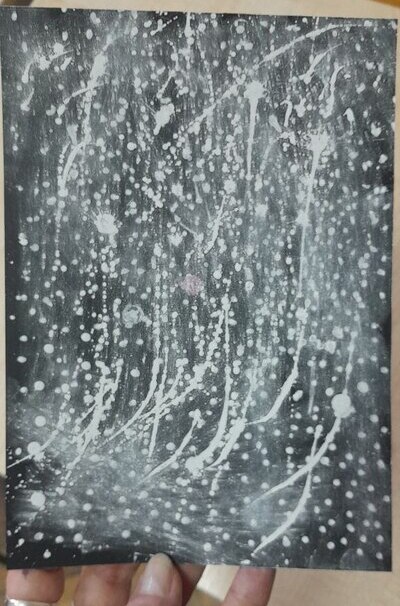
I decided to run this mini-series, as a part of my Teaching English Through Art thread, in order to preserve the memories and the creative process in a child as observed in my classes. Just stories from the classroom.
The lesson aka the context
It was one of our colour lessons, a colour-themed days on the autumn camp, White on Black, in which we used a mixed media technique to create ‘what you want’ which means that they could draw whatever and however.
It was one of those lessons that start with my students going ‘Whaaat?!’ looking at me taking out the resources of my bag (black paper, white chalk markers, white pencils, white tissue and glue and toothpaste and cotton buds) to ‘Look, miss Anka, look!’ because they have just discovered something more about the potential of all of these resources.
The kids could use one of these or all of these, in practically any way.
The student aka the artist
My student, Sasha, is eight, very clever, very creative and struggling with staying focused in our regular classes. And yet, in this lesson, Sasha stayed completely involved and on the task for about three hours straight (the lesson time and then the long lunch break). I was sitting there, monitoring and keeping an eye, trying to keep a straight face and my jaw from dropping. This expression, ‘I could not believe my own eyes’, it was created for this very situation.
The work and the creative process
The story started with a blank piece of black paper, A5. I noticed before that this very resource, so different from what we usually use, and so potent in its presence, just lying on the table, basically lots of Malevich’s black squares (well, rectangles) strewn all over the classroom, this very resource is already a statement in itself. It sets the mood for the lesson and it sparks creativity and inspiration instantly. The kids get their sheets and they immediately start interacting with them, turning them over, looking at the texture and turning it over and over again. This one never requires any tricks to get the kids into the task, the piece of paper does it.
As soon as we started, Sasha, without much hesitation, reached out for the chalk marker. I presume, it was all due to the fact that this one particular resource used to be out of bounds, ‘teacher only’, in the old classroom where we used to have a traditional board. Since we moved into the new classroom, with the electronic board and whiteboards, I have no use for them and I decided to use them in that Art lesson. Actually, those chalk markers apart from being a great tool for the teacher, they are also fascinating as a drawing or writing tool. They produce a neat, even line, you don’t need to apply to much pressure and, as my students quickly discovered, if you shake it, you can also produce splashes and spatters. In one word: lots of potential.
Splashes is what Sasha started with. He would shake the marker, look at the smudges that appeared and then he started to move the sheet, turning it upside down, shaking it, turning it around to help the liquid paint move further. To be honest, at this point, I did not think that ‘anything real’ would come out of but he was so engrossed in the process and he was enjoying it so much that I decided to let it be, instead of insisting on creating ‘something’. But, it really did remind me of another aritst, so I decided to show him a few works of Jackson Pollock and a few photographs from his studio and he was impressed. We looked but we also talked about finding your own style. Sasha was asking how you find it and whether I can suggest something to help him with defining his own style and I suggested ‘just working’ because things are defined and discovered in progress and at work.
Perhaps it was in an attempt to find your own style or perhaps only the next step in experimenting with the marker, but, all of a sudden, Sasha became really interested in dots and started to fill in the whole picture with them, all of the missing spaces, methodically, bit by bit. He even said ‘This really calms me down, these dots’. I decided to use it as an opportunity to bring up another concept, namely horror vacui and, again, we looked at some examples in the ancient Egypt paintings. And Sasha kept working.
It was somewhere at this point that I asked him to consider thinking of a name for his painting and at first he declined (‘I don’t know!’) and then he did what my students often do and go for the obvious (‘Crazy mess’). But it was not the end of it.
The painting was already quite something. I really liked the dots and splashes but the artist himself was still not happy and he kept experimenting. He realised that the chalk marker behaves like a proper chalk and leaves smudges on your hands or clothes and he decided to use it in a conscious way and he wiped the whole picture with his hand, not destroying it or rubbing off the lines or dots but covering it with a thin and delicate layer of white, kind of a mist.
This must have been the thing that gave him the idea for the actual name of the painting, namely ‘The Hedgehog in the Fog’, after a famous cartoon (and a book) by Yuri Nornstein, one of the most beautiful things ever made and my personal favourite. It was so fitting that I simply started to laugh.
Sasha continued to tweak the whole picture and then he left for lunch and when he came back, he showed me the finished painting. He also explained that he decided to add ‘the hedgehog’, a red dot, in the centre of the painting, to add one more reference, to Bansky, since that is the aritst and the concept that we did a few days earlier.
The teacher in awe
That is what I was. It is one of the many amazing things that happened in class that day but I love this story and this piece in particular because it beautifully illustrates how one child embarked on a journey of creative discovery and how he arrived at his finished product which, I have no doubt, is a masterpiece. All the hard work, all the focus, all the references and the curiosity that he demonstrated…I am proud of him and what he created and I am beyond happy that I could be a part of it.
Two months later…
…Sasha comes to me during the long break (he is ill and not going out to play outdoors) and asks if I can give him ‘the pen’ and ‘the paper’ so that he could draw another one of those pictures, like ‘The Hedgehog in the Fog’…And he was so happy when we found the last sheet of the black paper! I left him to himself and he kept working.
In the end, he kept blagging to everyone that he bumped into about the painting that he created ‘and that I decided to call ‘The Bear in the Fog because the first one that I have at home is called ‘The Hedgehog in the Fog’ and now I had to choose a different name…’
When it was my time to listen, I praised him, again and asked if he made the little dot pink.
‘NO! I made it red. Just like you told us last time!’, he said.
And he went on with his things and I was left with wondering how magical it is that my amazing permanently distracted Sasha not only heard what I was telling him (and the class) a few months before, about Banksy and about Warhol, but he also remembered it and made it his. Forever?

Happy teaching!